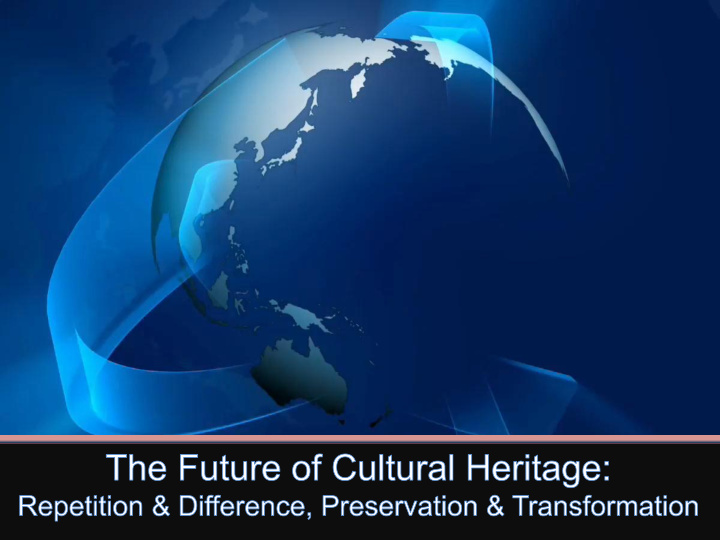



Riel Miller, UNESCO, 2012
Riel Miller Head of Foresight Riel Miller, UNESCO, 2012
The Emergent Present: Repetition & Difference • In an emergent present the only constant is change – the change of that which repeats and that which is different. • The future only exists in the present as anticipation. Time and space make anticipation an inherent attribute of all phenomena. Anticipatory systems are both animate and inanimate. • Science as practice is a conscious approach to constantly renegotiating the meaning of reality. Riel Miller, UNESCO, 2012
Distinguishing different kinds of change. Riel Miller, UNESCO, 2012
Riel Miller, UNESCO, 2012
Riel Miller, UNESCO, 2012
Convergence: Catch-up with the leader Riel Miller, UNESCO, 2012
Leap-frog: From behind to being ahead Leap-frog to where? Riel Miller, UNESCO, 2012
What is the Question?Thinking about systemic change Change within Change outside the system the system Inside-in Inside-out Outside-in Outside-out Riel Miller, UNESCO, 2012
What is the context for the processes of CH selection? Regime 3 Greater ( Learning Less freedom intensive manageab Regime 2 and society ) le – less ( Industrial ) ambiguity - clarity of spontaneity goal More Different contexts and times? manageab Regime 1 le – more ( Agriculture ) clarity of goal More reflexivity Less reflexivity What role for the industrial era state? Riel Miller, UNESCO, 2012
Knowledge creation as the constant renegotiation of our relationship to reality – repetition & difference Discovery (flow) Public sector Living knowledge (stock) Net Preservation new Cover it all Non-institutional Private sector Net Preservation new Source: Etienne Wegner Riel Miller, UNESCO, 2012
Stocks & Flows, Repetition & Difference, Continunity & Disruption • What repeats? • How does it repeat? • Why should it repeat? • When should it not repeat? • Difference – why, when, where, how? • How does difference change repetition? • Thinking about the conditions for birth and death – the role of conscious action? Riel Miller, UNESCO, 2012
“ Mode 1 (knowledge production) refers to a form of knowledge production – a complex of ideas, methods, values, norms – that has grown up to control the diffusion of the Newtonian (empirical and mathematical physics) model to more and more fields of enquiry and ensure its compliance with what is considered sound scientific practice .” Gibbons et. al. The New Production of Knowledge, 1994, p. 2 Riel Miller, UNESCO, 2012
“Mode 2 knowledge is carried out in a context of application. Mode 1 is disciplinary while Mode 2 is transdisciplinary. Mode 1 is characterised by homogeneity, Mode 2 by heterogeneity. Organisationally, Mode 1 is hierarchical and tends to preserve its form, while Mode 2 is more heterarchical and transient .” Gibbons et. al. The New Production of Knowledge, 1994, p. 2 Riel Miller, UNESCO, 2012
Mode 3? Changing conditions of birth & death, repetition & difference • Unique creation • Banal creativity • Heterarchical wealth • Few firms • Few “jobs” • Mode 1 is marginal • Mode 2 is general but not dominant • We know the means, we know the ends but what are the models Riel Miller, UNESCO, 2012 that make action operational?
Riel Miller, UNESCO, 2012
Not much to be done about all of this. Co- Success in Endogenous existenc achieving stasis change – within without change e Disruptive system reform to Success in coexistenc maintain system e achieving stasis Transfor conditions with change mation Riel Miller, UNESCO, 2012
Transformative policies: enabling experimentation and novelty • Identity: Easy “Collective Me” – Cyber-citizenship – who am I and avatars, privacy control • Signalling: Easy sense making – new accounting – Knowbank – a competency “bank” that identifies, validates and assists with signalling what people know how to do • Community: Easy birth-death, entry-exit – creating, joining, leaving “contractual” relationships – payment, credit, etc. • Credit and Payment: Easy linking – iCredit – money and asset infrastructure, founded on cyber- citizenship and knowbank assets for “credit worthiness” • Trust: Easy refinement of evaluative capacities – Collective intelligence query systems that use big data pooling to provide feedback that extends and deepens experimentation Riel Miller, UNESCO, 2012
Conditions for selection: stock and flow • Knowing thy self – Creating the capacity to select • Research governance – Using the science of uniqueness to generate collective outcomes spontaneously • Being part and apart – Capacity to initiate birth, death, entry, Riel Miller, UNESCO, 2012
Use the Future: Scientific Knowledge Creation to Identify Repetition and Difference • Level 1 use of the future – extrapolation reveals the systems/models of current anticipatory assumptions (e.g. STEEP trends, forecasting, etc). • Level 2 use of the future – models of systemic discontinuity enable re-framing and “transformation” of anticipatory assumptions. • Level 3 use of the future – distinguish systemic continuity and discontinuity, endogenous and exogenous systemic repetition and difference: i.e. strategic (systemically distinct) choices. Riel Miller, UNESCO, 2012
How we anticipate matters it changes the present. Thank you Riel Miller rielm@yahoo.com Image: Sempe Riel Miller, UNESCO, 2012
Recommend
More recommend